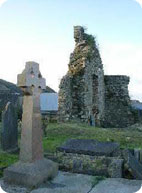Saint Mary’s
St. Mary’s Church stood further east of St. Patrick’s, which it resembled in design, but was more beautiful in detail. The capitals of the pillars, the mouldings of the arches, the tracery of the widows being more ornamental than those of either Selskar or St. Patrick’s.
It was, on the testimony of the late Father Corrin, the last Parochial Church in use from the time of the Reformation until the building of the new Churches in 1858. St. Mary’s was plundered and destroyed by Cromwell’s soldiers in the awful days of 1649.
Dr. Nicholas French, Bishop of Ferns, was the last Parish Priest of St. Mary’s from 1638 until he was driven into exile in 1651. His residence was the large house at the top of Peter Street (now divided into two houses).
At the rear of this house is the traditionally known “Bishop’s Garden” extending down to the walls of St. Mary’s churchyard. The doorways leading from the garden to the Church precincts, though built up, are still clearly. discernible today.
Dr. French was not in residence at Peter Street during the time of Cromwell’s slaughter, being ill in the town of Ross, but from his letter to the Internuncio at Brussels describing the awful events of that day it is easy to visualise the fate that befell the priests and people of St. Mary’s. He writes:
“There before God’s Altar fell many sacred victims, holy Priests of the Lord, others who were seized outside the precincts of the Church were scourged with whips; others hanged and others put to death by various cruel tortures. The best blood of the citizens was shed; the very squares were inundated with it and there was scarcely a house that was not defiled with carnage: and full of wailing. In my own Palace, a youth, hardly 16 years of age, an amiable boy, as also my gardener and sacristan were cruelly butchered, and the Chaplain whom I caused to remain behind me at home was transfixed with six mortal wounds. These things were perpetrated in open day by the impious assassins, and from that moment I have never seen my city or my flock or my native land or my kindred.”
This crushing blow fell on the parish of St. Mary’s in 1649. Her ruined walls were to stand against wind and weather until on the 4th June 1822 they were struck by a thunderbolt during the awful storm that raged over the town.
Today there stands but a single wall, a lonely sentinel guarding faithfully the tragic memories of the past.

